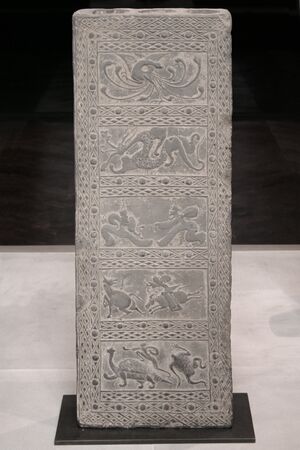الجبال المقدسة للصين
الجبال المقدسة للصين تنقسم إلى عدة مجموعات. الجبال الخمس العظمى (الصينية المبسطة: 五岳; الصينية التقليدية: 五嶽; پنين: Wǔyuè) refers to five of the most renowned mountains in Chinese history,[1] and they were the subjects of imperial pilgrimage by emperors throughout ages. They are associated with the supreme God of Heaven and the five main cosmic deities of Chinese traditional religion. The group associated with Buddhism is referred to as the Four Sacred Mountains of Buddhism (四大佛教名山; Sì dà fójiào míngshān), and the group associated with Taoism is referred to as the Four Sacred Mountains of Taoism (四大道教名山; Sì dà dàojiào míngshān).
The sacred mountains have all been important destinations for pilgrimage, the Chinese expression for pilgrimage (朝圣; 朝聖; cháoshèng) being a shortened version of an expression which means "paying respect to a holy mountain" (朝拜圣山; 朝拜聖山; cháobài shèng shān).
الجبال الخمس العظمى


The Five Great Mountains or Wuyue are arranged according to the five cardinal directions of Chinese geomancy, which includes the center as a direction. The grouping of the five mountains appeared during the Warring States period (475 BC – 221 BC),[3] and the term Wuyue ("Five Summits") was made popular during the reign of Emperor Wudi of the Western Han Dynasty 140-87 BC.[1] In Chinese traditional religion they have cosmological and theological significance as the representation, on the physical plane of earth, of the ordered world emanating from the God of Heaven (Tian–Shangdi), inscribing the Chinese territory as a tán (壇; 'altar'), the Chinese concept equivalent of the Indian mandala.
انظر أيضاً
- الجبال المقدسة
- Grotto-heavens, Sacred grottoes, sometimes associated with sacred mountains
جبال أخرى ذات أهمية روحية/دينية في الصين
- Three Famous Mountains (Three Shan, 三山)
- Five Garrison Mountains (Five Zhen, 五镇)
- Mount Lao
- Mount Mian
- Mount Sanqing
- Gongga
- Mount Changbai - regarded by Manchus of the Qing dynasty as Holy Mountain
- Kunlun Mountains - the location of the peach tree of immortality wardened by Xiwangmu, the Queen Mother of the West
- Mount Tian
- Three Holy Mountain Peaks at Daocheng
- Chanodug
- Chenresig
- Jambeyang
- Four Sacred Mountains in Tibetan Buddhism
الهامش
- ^ أ ب Julyan, Robert Hixson (1984). Mountain names. Mountaineers Books. p. 199. ISBN 9780898860917.
- ^ Sun & Kistemaker (1997), p. 121.
- ^ Little, Stephen; Eichman, Shawn (2000). Taoism and the Arts of China. University of California Press. p. 148. ISBN 9780520227859.
ببليوگرافيا
- Robson, James (2009). Power of Place: The Religious Landscape of the Southern Sacred Peak (Nanyue) in Medieval China. Cambridge, Massachusetts: Harvard University Asia Center.
- Sun, Xiaochun; Kistemaker, Jacob (1997). The Chinese Sky During the Han: Constellating Stars and Society. Brill. ISBN 9004107371.
وصلات خارجية
- Google Maps Pro of 15 Sacred Mountains in China
- Google Earth Map of both Five and Four Sacred Mountains KMZ File
- 中国的宗教与环境 [Religion and the environment in China]. chinadialogue.—Why the five sacred mountains survive in a good ecological state
- A Report on the Nine Sacred Mountains
- Short description is different from Wikidata
- Articles containing simplified Chinese-language text
- Articles containing traditional Chinese-language text
- Articles containing Chinese-language text
- Articles containing صينية-language text
- قوائم إحداثيات
- Geographic coordinate lists
- Articles with Geo
- CS1 uses الصينية-language script (zh)
- جبال مقدسة في الصين
- البوذية في الصين
- الطاوية في الصين
- مباني ومنشآت دينية في الصين
